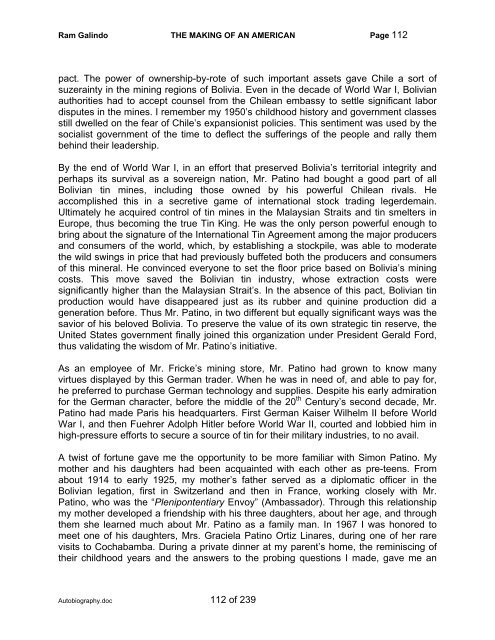Autobiography - The Galindo Group
Autobiography - The Galindo Group
Autobiography - The Galindo Group
You also want an ePaper? Increase the reach of your titles
YUMPU automatically turns print PDFs into web optimized ePapers that Google loves.
Ram <strong>Galindo</strong> THE MAKING OF AN AMERICAN Page 112<br />
pact. <strong>The</strong> power of ownership-by-rote of such important assets gave Chile a sort of<br />
suzerainty in the mining regions of Bolivia. Even in the decade of World War I, Bolivian<br />
authorities had to accept counsel from the Chilean embassy to settle significant labor<br />
disputes in the mines. I remember my 1950’s childhood history and government classes<br />
still dwelled on the fear of Chile’s expansionist policies. This sentiment was used by the<br />
socialist government of the time to deflect the sufferings of the people and rally them<br />
behind their leadership.<br />
By the end of World War I, in an effort that preserved Bolivia’s territorial integrity and<br />
perhaps its survival as a sovereign nation, Mr. Patino had bought a good part of all<br />
Bolivian tin mines, including those owned by his powerful Chilean rivals. He<br />
accomplished this in a secretive game of international stock trading legerdemain.<br />
Ultimately he acquired control of tin mines in the Malaysian Straits and tin smelters in<br />
Europe, thus becoming the true Tin King. He was the only person powerful enough to<br />
bring about the signature of the International Tin Agreement among the major producers<br />
and consumers of the world, which, by establishing a stockpile, was able to moderate<br />
the wild swings in price that had previously buffeted both the producers and consumers<br />
of this mineral. He convinced everyone to set the floor price based on Bolivia’s mining<br />
costs. This move saved the Bolivian tin industry, whose extraction costs were<br />
significantly higher than the Malaysian Strait’s. In the absence of this pact, Bolivian tin<br />
production would have disappeared just as its rubber and quinine production did a<br />
generation before. Thus Mr. Patino, in two different but equally significant ways was the<br />
savior of his beloved Bolivia. To preserve the value of its own strategic tin reserve, the<br />
United States government finally joined this organization under President Gerald Ford,<br />
thus validating the wisdom of Mr. Patino’s initiative.<br />
As an employee of Mr. Fricke’s mining store, Mr. Patino had grown to know many<br />
virtues displayed by this German trader. When he was in need of, and able to pay for,<br />
he preferred to purchase German technology and supplies. Despite his early admiration<br />
for the German character, before the middle of the 20 th Century’s second decade, Mr.<br />
Patino had made Paris his headquarters. First German Kaiser Wilhelm II before World<br />
War I, and then Fuehrer Adolph Hitler before World War II, courted and lobbied him in<br />
high-pressure efforts to secure a source of tin for their military industries, to no avail.<br />
A twist of fortune gave me the opportunity to be more familiar with Simon Patino. My<br />
mother and his daughters had been acquainted with each other as pre-teens. From<br />
about 1914 to early 1925, my mother’s father served as a diplomatic officer in the<br />
Bolivian legation, first in Switzerland and then in France, working closely with Mr.<br />
Patino, who was the “Plenipontentiary Envoy” (Ambassador). Through this relationship<br />
my mother developed a friendship with his three daughters, about her age, and through<br />
them she learned much about Mr. Patino as a family man. In 1967 I was honored to<br />
meet one of his daughters, Mrs. Graciela Patino Ortiz Linares, during one of her rare<br />
visits to Cochabamba. During a private dinner at my parent’s home, the reminiscing of<br />
their childhood years and the answers to the probing questions I made, gave me an<br />
<strong>Autobiography</strong>.doc 112 of 239


